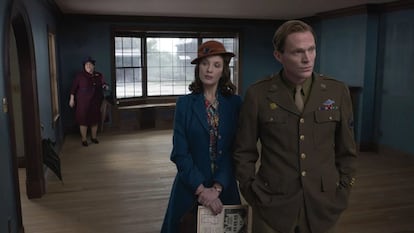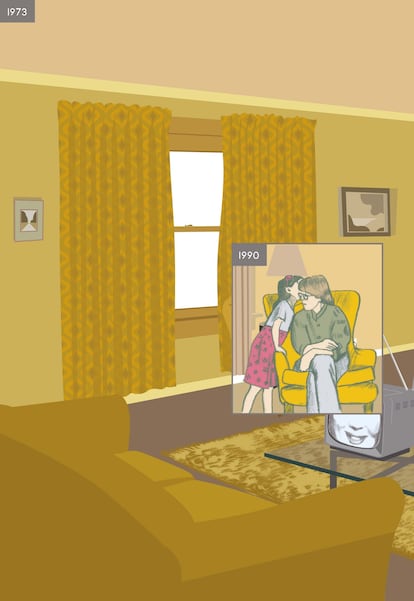Three whole floors. Even Richard McGuare himself confesses that he was fascinated. The oldest thing that was exposed was a wooden statuette, which he did when he was seven years old. The ultimate is still under development, now that it brushes the 70. He considers them “musical drawings”, pages of a coming book, for the moment entitled Listen (Listen). In between, there were punk music, illustration, children’s literature, sculptures, journal covers such as The New Yorkercinema, animation, toys or urban art. The public could see, listen, touch. And, it can be supposed, to be amazed at a race of six decades and infinite roads. “A creator who has lived 1,000 artistic lives,” summarized Commissioner Anette Gehrig, in the video that presented the greatest retrospective dedicated to the author, in 2024 in the Cartoonmuseum of Basel, in Switzerland. Of course, original sheets of Herethe graphic novel that changed the story of McGuare, of the comic and even of a few followers who swore eternal love back in 2014. Chris Ware, another celebrating cartoonist, said that each one would remember the exact moment in which he began to read it.
And that McGuare (New Jersey, 68 years old) is still not considered a cartoonist. “I have never had a formula. I feel that my work is guided by ideas. Obviously, I also make comics. But most comics authors create their own world and I do not consider it so relevant, just like having my style. My style is the ideas,” he said last Thursday in Madrid. Just before inaugurating the first city comic fair, in another sample of its impact: in search of a prestigious name for its start, the event opted for the head of the “iconic” Hererecently reissued by Salamandra Graphic and adapted to the cinema by Robert Zemeckis. Hence, the interview with the author approached his most famous piece, but also the multiple facets of an unabarcable talent. Except, perhaps, dedicating three floors of a museum.
Somehow, his masterpiece encloses part of the author’s essence. Here It never moves from a fixed framing: the vignettes portray a concrete corner again and again. They do not stop, however, to travel through time, history and fantasy, to imagine everything that could happen there. The same point where a bison settled in 10,000 Before Christ witnessed a logging of trees in 1763, he ended up becoming the living room of a house in the early twentieth century, where a family sees television in 1999. McGuire himself has always maintained some starting points: minimalism, objects and daily references, musicality. However, he has taken them where I would like, whether it was a story of conceptual love between Popeye and Oliviathe children’s story of an orange (which Salamandra Graphic plans to publish soon in Spanish), record covers of his band, Liquid Liquid, or a game of cards. The catalog of the sample in Basel, in fact, evoked Here: He placed very different dates works to underline the contact elements. “As soon as I have the idea, I visualize the entire project. It is a classic. And then I perceive that I know how to do it,” he explains.
That of Popeye and Oliviafor example, it came for a weekend of retirement between silence and calligraphy exercises in a monastery. His most famous creation, on the other hand, arose from a mixture: the words he heard the author of MausArt Spiegelman (“comics are narrative diagrams”); The deserved rest after a move, when he suddenly thought who would have occupied that room before; and a friend who taught him enthusiastic the computer who had just bought. “He showed me (one of the first versions of the computer program) Windows. And as soon as many windows began to appear I could show different moments in time,” he recalls. It was 1989 and McGuare embodied all that in six pages: the first version of Here.
Before, there was a young man passionate about art, bassist of the Punk Liquid Liquid group, which overturned his graphic impulse in the band’s album covers or in urban creation pieces. Then, a comic legend began to be written. Although it took more than 20 years to finish. McGuare always wanted to expand the work until he became a book. I knew I had to use a “simple, realistic” style, not to get something that I already saw quite complex. I was so sure that he signed an editorial contract to carry it forward, without having just anything. However, life and doubts extend the process. McGuare went to Paris to direct animation films, was taking steps forward and behind, starting and stopping, walking many routes, just like the comic itself. But it never reached the goal. Meanwhile, he was sometimes “terrified.”
Until it was selected for a residence from a New York Public Library. “I never thought they would choose me. Suddenly, they gave me an office, money, I was surrounded by serious writers and forced to present my work to others. I felt that I had to try myself,” he recalls. I doubted, yes, that the public could connect with a book without more protagonists than space.
When a reporter from The New York Times He told him that Here He had excited him, for the first time he felt that someone “objective”, not his surroundings, appreciated that comic. Millions came more. “I think that, in a way, anyone looks in Him. People see it as a photo album, they relate it to raising in their own families. I understand that that is why it is moving,” says McGuare. A theater company in a Norwegian islet, virtual reality developers in the United Kingdom or a filmmaker like Zemeckis are among those who have adapted the graphic novel. The script also circulated for a series, with gender and framing changes, but the director ruled out, choosing to imitate the original work and never move the camera.

McGuare, in any case, continues to be amazed at so successful. Until the signing of Tom Hanks was announced, he was convinced that the film would never go ahead. He usually see him as if he had composed a song that many are versioning. His, after all, was the theme of Liquid Liquid Cavernthat other groups took as inspiration and White Linesby Grandmaster Flash and Melle Mel, copied so much that an extrajudicial agreement was needed. “You have created something expandable indefinitely,” he recently recognized him about Here A friend.
His own universe continues to expand. He still edits and retouches music, prepares sculptures and, above all, a new book, at the same time “opposite and good partner” of Here. “It will be similar in size, and as for the relationship with time. But it will show everything that happens in the world, or in space, in just a minute,” he describes. Once again, several impulses allied themselves until the central idea was forged: to their musical reflections and sound diagrams that he was drawing, the pressure for the promotion of the Zemeckis film was added. “I woke up in the middle of the night: ‘God, now they will ask me about my next project! You should take the book!” McGuare says. Your editors will also appreciate it. Although Salamandra Graphic trusts so much that he already bought Listen Four years ago, without having seen a single page.
That is the status of McGuire. “I’m still feeling a connection with the boy who was. Although I don’t have to fight so much, to earn money, against my insecurities, to get opportunities. Now I feel like a child who plays,” he says. “Everything is going well,” seems to close. “Unless the world is running out,” he adds. Inevitable, then, ask you a last question.
The author says that he is really concerned with the policies of the US president, Donald Trump, who fears for the future of his beloved magazine The New Yorkerof artists in general and their own: “All these opportunities that we have now can disappear.” He says that, from time to time, he contacts some friends living in Canada, so that they take into account if he needed an exit. Then he laughs, but not quite. And quotes the creators who fled from Germany who was hugging totalitarianism: “It is terrifying. I don’t know what can happen.” We will see it. At the moment, we are here.

